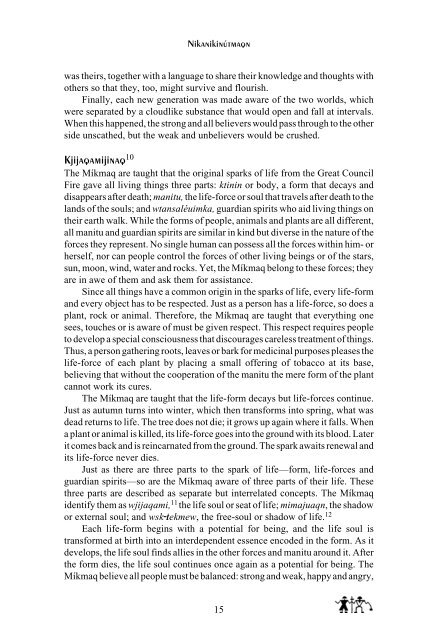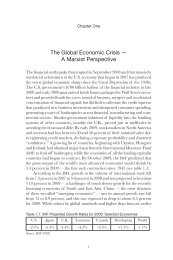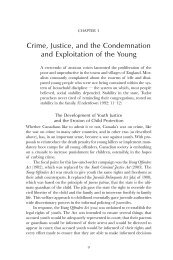Download PDF - Fernwood Publishing
Download PDF - Fernwood Publishing
Download PDF - Fernwood Publishing
Create successful ePaper yourself
Turn your PDF publications into a flip-book with our unique Google optimized e-Paper software.
Nikanikinútmaqn<br />
was theirs, together with a language to share their knowledge and thoughts with<br />
others so that they, too, might survive and flourish.<br />
Finally, each new generation was made aware of the two worlds, which<br />
were separated by a cloudlike substance that would open and fall at intervals.<br />
When this happened, the strong and all believers would pass through to the other<br />
side unscathed, but the weak and unbelievers would be crushed.<br />
Kjijaqamijinaq 10<br />
The Míkmaq are taught that the original sparks of life from the Great Council<br />
Fire gave all living things three parts: ktinin or body, a form that decays and<br />
disappears after death; manitu, the life-force or soul that travels after death to the<br />
lands of the souls; and wtansaléuimka, guardian spirits who aid living things on<br />
their earth walk. While the forms of people, animals and plants are all different,<br />
all manitu and guardian spirits are similar in kind but diverse in the nature of the<br />
forces they represent. No single human can possess all the forces within him- or<br />
herself, nor can people control the forces of other living beings or of the stars,<br />
sun, moon, wind, water and rocks. Yet, the Míkmaq belong to these forces; they<br />
are in awe of them and ask them for assistance.<br />
Since all things have a common origin in the sparks of life, every life-form<br />
and every object has to be respected. Just as a person has a life-force, so does a<br />
plant, rock or animal. Therefore, the Míkmaq are taught that everything one<br />
sees, touches or is aware of must be given respect. This respect requires people<br />
to develop a special consciousness that discourages careless treatment of things.<br />
Thus, a person gathering roots, leaves or bark for medicinal purposes pleases the<br />
life-force of each plant by placing a small offering of tobacco at its base,<br />
believing that without the cooperation of the manitu the mere form of the plant<br />
cannot work its cures.<br />
The Míkmaq are taught that the life-form decays but life-forces continue.<br />
Just as autumn turns into winter, which then transforms into spring, what was<br />
dead returns to life. The tree does not die; it grows up again where it falls. When<br />
a plant or animal is killed, its life-force goes into the ground with its blood. Later<br />
it comes back and is reincarnated from the ground. The spark awaits renewal and<br />
its life-force never dies.<br />
Just as there are three parts to the spark of life—form, life-forces and<br />
guardian spirits—so are the Míkmaq aware of three parts of their life. These<br />
three parts are described as separate but interrelated concepts. The Míkmaq<br />
identify them as wjijaqami, 11 the life soul or seat of life; mimajuaqn, the shadow<br />
or external soul; and wsk itekmew, the free-soul or shadow of life. 12<br />
Each life-form begins with a potential for being, and the life soul is<br />
transformed at birth into an interdependent essence encoded in the form. As it<br />
develops, the life soul finds allies in the other forces and manitu around it. After<br />
the form dies, the life soul continues once again as a potential for being. The<br />
Míkmaq believe all people must be balanced: strong and weak, happy and angry,<br />
15





